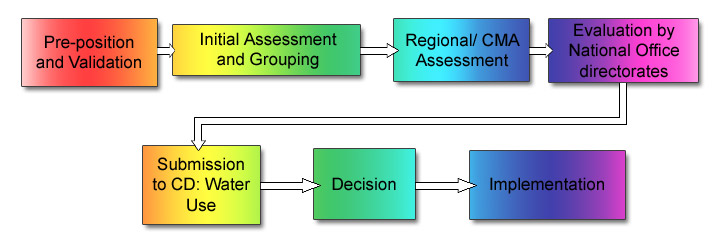Your application for a water use licence will be taken in by the Regional Office
of the Department of Water and Sanitation. The Regional Office will charge
a licence processing fee, and will do an initial assessment in the Rgional
Office. Your licence application will then be transferred to the Head Office for
further processing. The following diagramme outlines the process that will be
followed.

If you want to start using water, or expand your existing use of water, you will
probably need a licence to do so. Licences are also needed to;
- Store water
- For new commercial forests
- Impeding or diverting the flow in a river
- Engaging in controlled activities
- Discharging waste to any water resource
- Disposing of waste in a way which could affect the water resource
|
- Disposing of heated water
- Altering the bed, banks course or characteristics of the water resource
- Removing, discharging or disposing of water found underground and
- For some recreational uses
|
Please contact your Regional
DWS Office if you are unsure if your use of water use needs a licence.
If you need a licence for your water use, you will need to apply to your
Regional Office of the Department of Water and Sanitation. If a Catchment
Management Agency is in place they may be able to issue the licence. Licence
application forms can be downloaded from the Water Use Registration and
Licensing page.
There are generally 6 steps to processing any licence. These steps aim to test
the application against the principle of "beneficial use in the public interest",
and specifically against Section 27 of the National
Water Act (NWA) [PDF
- 239 KB]. These steps are;
Step 1 - Pre-position and validation. This is done when your
licence application is received, and is used to check if everything needed to
process the licence is available. You will be asked to provide missing
information, and may get initial feedback before you pay your application fee (R
114.00 in 2007) - so you can decide whether to continue.
Step 2 - Initial assessment and grouping. This includes a quick
assessment of the possible impacts and benefits of the proposed water use. In
some cases a simple set of questions will be used to help make this assessment.
You can use the
Screening Tool to do your own pre-assessments.
Step 3 - Regional Assessment. This step is done in the regional
office where you made your application. The regional office gathers all the
information required to make a decision on whether to approve the application,
and makes a recommendation to the national office.
Step 4 - Evaluation by the National Office. Your application is
then evaluated by specialist groups. These groups also make recommendations on
the application. The application is then submitted to the Chief Director: Water
Use for a decision.
Step 5 - Decision by the Chief Director: Water Use.
After considering all the relevant information, the Chief Director: Water Use
will make a decision on whether to approve the application.
Step 6 - Implementation. Once a decision has
been made, the Rgional Office will be informed, and they can start with
implementing the licence. They will then inform you of the outcome of the
application, and if approved will issue you the licence as well as highlighting
any conditions that might be attached to your water use.
Your licence can take anything from 3 to 12 months to process, depending on the
complexity of the licence, its benefits to the nation, and its possible impacts.
Generally, low impact, high value licences will be processed quicker. You may
also be asked, at any stage, to provide more information, or to advertise the
proposed water use, and to invite interested and affected parties to comment.
A licence cannot be issued for a period longer than 40 years, but may be issued
for shorter periods if necessary.
>> Water Use Registration and Licensing forms